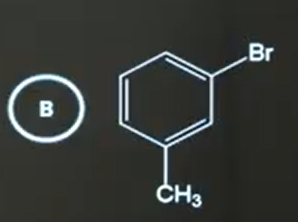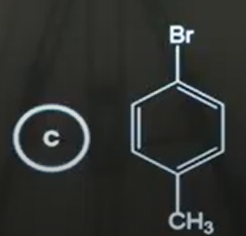Which of the following reactions gives yellow precipitate for the following sequence
1.NaOH
2.dil HNO3
3. AgNO3




The correct Answer is:D
To solve the problem, we need to analyze the sequence of reactions step by step and identify which compound will yield a yellow precipitate when treated with the given reagents: NaOH, dilute HNO3, and AgNO3.
Step 1: Identify the Halogenated Compounds
The question involves compounds that contain halogens (Cl, Br, I) attached to a benzene ring. The key here is to identify which halogen can form a yellow precipitate with silver nitrate (AgNO3).
Step 2: Reaction with NaOH
When NaOH is added to the halogenated compound, it will lead to the substitution of the halogen with a hydroxyl group (OH) or the formation of a corresponding alkali metal halide.
- For example, if we have a compound with Iodine (I), the reaction would lead to the formation of sodium iodide (NaI) and the corresponding alcohol.
Step 3: Addition of Dilute HNO3
The next step involves adding dilute HNO3. This step will acidify the medium but does not directly affect the halide ions. The iodide ion (I-) remains in the solution.
Step 4: Addition of AgNO3
Finally, when AgNO3 is added to the solution, it will react with the iodide ions present. The reaction is as follows:
Ag++I−→AgI
This reaction produces silver iodide (AgI), which is known to form a yellow precipitate.
Conclusion
From the above steps, we conclude that the presence of iodine (I) in the halogenated compound is necessary to produce a yellow precipitate of silver iodide (AgI) when AgNO3 is added. Therefore, the correct option that gives a yellow precipitate is the one containing iodine.
Final Answer
The compound that gives a yellow precipitate when treated with the sequence of reagents is the one containing iodine (I).
---
The question involves compounds that contain halogens (Cl, Br, I) attached to a benzene ring. The key here is to identify which halogen can form a yellow precipitate with silver nitrate (AgNO3).
When NaOH is added to the halogenated compound, it will lead to the substitution of the halogen with a hydroxyl group (OH) or the formation of a corresponding alkali metal halide.
- For example, if we have a compound with Iodine (I), the reaction would lead to the formation of sodium iodide (NaI) and the corresponding alcohol.
The next step involves adding dilute HNO3. This step will acidify the medium but does not directly affect the halide ions. The iodide ion (I-) remains in the solution.
Finally, when AgNO3 is added to the solution, it will react with the iodide ions present. The reaction is as follows:
Ag++I−→AgI
This reaction produces silver iodide (AgI), which is known to form a yellow precipitate.
From the above steps, we conclude that the presence of iodine (I) in the halogenated compound is necessary to produce a yellow precipitate of silver iodide (AgI) when AgNO3 is added. Therefore, the correct option that gives a yellow precipitate is the one containing iodine.
The compound that gives a yellow precipitate when treated with the sequence of reagents is the one containing iodine (I).
Similar Questions
Knowledge Check
Which of the following will give yellow precipitate with l2/NaOH?
ACH3−CO−O−CO−CH3BI−CH2−O∣∣C−CH2−CH3CCH3−CO−NH2DCH3−OH∣∣C−CH2−CH3Which of the following will give yellow precipitate with l2/NaOH?
AlCH2COCH2CH3BCH2COOCOCH3CCH3CONH2DCH3CH(OH)CH2CH3Which of the following will give yellow precipitate with I2/NaOH-
AICH2COCH2CH3BCH3COOCOCH3CCH3CONH2DCH3CH(OH)CH2CH2
Which of the following does not give yellow precipitate with NaOH+KI?
View SolutionWhich of the following does not give yellow precipitate with AgNO3 ?
View SolutionWhich of the following does not give yellow precipitate with I2 and NaOH
View SolutionWhich of the following will not give a precipitate with AgNO3 ?
View SolutionWhich of the following ketones will not give yellow precipitate with NaOH/I2 ?
View Solution

